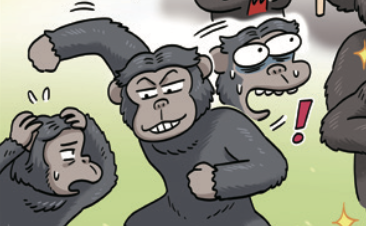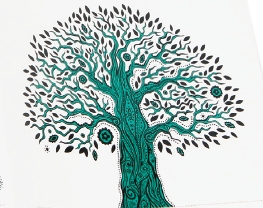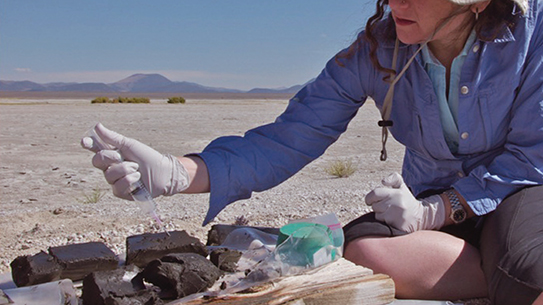잡아먹히지 않는 신비로운 나비
자연의 모든 것은 먹고 먹히는 것들이다. 지난 1990년 플로리다 주립대학의 생물학자인 존 글렌디닝씨와 링컨 브라우어씨는 식용성과 생존성에 관련된 매우 재미있는 사례를 발표했다.
제왕나비를 생각해보자. 이 나비는 여러면에서 매우 특이하다. 첫째, 제왕나비는 몹시도 큰 나비로서 그 날개는 각각 4인치씩이나 된다. 둘째, 금갈색의 날개에 짙은 선과 흰점이 표시된 매우 아름다운 나비다.
이 제왕과 관련하여 가장 신비로운 점은 철을 따라 이동한다는 점인데 이는 곤충류로서는 유일한 셈이다. 가을이 되면 수천마리의 제왕들은 미국에서 모여 멕시코 중부를 향해 남쪽으로 날기 시작한다. 봄이오면 다시 북으로 돌아오거나 적어도 돌아오고자 노력한다. 오는 중에 알을 까게 되면 대부분 죽고 말지만 말이다. 그러나 태어난 새 세대들은 안내자도 없이 다시 북으로 여름나라를 향해 이동하는 것이다.
나비처럼 미미한 생명체들이 어떻게 남으로, 그리고 다시 북으로 1천8백마일씩에 가까운 원거리를 날 수 있는 힘을 가졌는지 의문이다. 어떻게 알에서 깬 나비들이 부모도 없이 돌아가는 길을 아는지도 알 수 없다.
나아가서, 마치 이 정도는 아무 것도 아니라는 듯이, 제왕나비의 애벌레들은 유액풀을 배불리 먹는다. 이것이 무엇이 그리도 신기하냐고? 다름아니라 유액풀속엔 척추동물의 심장에 심한 중독성 효과를 가져오는 '카디악 글리코사이드'라는 화학성분이 들어있다. 한예로 새는 이를 많이 먹게되면 심장이 멈추며 죽게 된다. 적은 양을 섭취하더라도 구토증이 생기는 등 아주 불쾌한 느낌을 가져오는 것이다.
제왕나비의 애벌레들은 이 카디악 글리코사이드의 해독성에 전혀 영향을 받지 않으며 세포속에 담은채 나비로 성장할 때까지 고이 간직한다.
그 결과는 자명하다. 가끔 제왕나비나 그 애벌레를 접해보지 못한 어리고 경험없는 새가 이 먹음직스러운 먹이를 조금이라도 삼키면 그 즉시 입에 문 나머지를 뱉어내고 입에 남은 맛을 없애려고 애쓰지만 병들어버리게 된다. 그런 새는 다시는 제왕나비를 잡아먹으려 하지 않는다. 한번의 경험이면 족한 것이다.
그 결과 제왕나비는 - 비록 새 한마리마다 제왕 한마리씩 희생되는 값을 치르긴 하지만 - 적어도 그런 식으로 잡아먹히는 상황으로부터는 안전해진다는 것이다.
사실, 제왕보다 약간 작지만 색깔이 매우 비슷한 나비로서 '총독나비'라는 것이 있다. 무차별적인 진화덕택에 제왕을 많이 닮은 이 나비는 번식이 가능하도록 오랜 삶을 산다. 이 총독은 삼켜도 아무 탈이 없건만 한번 제왕을 먹어본 쓰라린 경험이 있는 새들은 총독나비 근처엔 얼씬거리지도 않으려든다. 모험을 또다시 하기 싫어서다.
그러나 언제나 예외라는 것이 있어서(이 역시 무차별적인 진화덕택이다) 어떠한 독성에 면역을 개발한 동물들이 존재하기 마련이다. 이와같은 면역은 엄청난 혜택으로서 남들이 접근하지 못하는 생명체들을 잡아먹을 수 있는 만큼 방대한 식량공급량을 의미한다.
글렌디닝씨와 브라우어씨는 페로미스쿠스 멜라노티스라는, 다른 작은 척추동물들을 죽이는 카디악 글리코사이드에 전혀 피해를 입지 않는 멕시코 중부지역의 쥐를 연구했다. 이 쥐들은 제왕나비들이 모여드는 지역에 몰려가 배가 터지도록 먹는다. 이 쥐와 관련있는 다른 쥐는 그렇게 못했다. 그만 죽어버린 것이다.
그 결과로 페르미스쿠스 멜라노티스는 그 지역에선 가장 확실하고 가장 많은 먹이를 가진 쥐가 되었다. 물론 카디악 글리코사이드에 견딜 수 있는 능력을 소유한 여러 종류의 동물들이 존재한다면 제왕들에겐 치명적인 것이지만 그것은 진화상 그렇게 쉬운 일은 아닌듯 하다. 이 한가지 쥐 종류만 제외하고선 제왕나비들은 생존에 위협이 없는 것이다.
명백히 이는 강한 방어가 결국 모든 공격으로부터의 보호막이 될 수는 없다는 유일한 사례는 아니다.
예를 들어, 큰 짐승들은 성난 벌들을 피하는 것이 상례이지만 벌에게 쏘이지 않고 삼키기전에 독침을 뽑아 뱉어내는 기술을 가진, 벌들만 전문적으로 잡아먹는 새들도 있다.
또한 곤충을 가둔 후 소화시키는 식충식물이 있는 반면 역으로 그런 식물을 먹는 방법을 터득해서 잡아먹힐 일에 전혀 신경을 쓰지않는 곤충들도 있다.
내게 가장 신비스러운 것은 인간에겐 잔인하도록 살인적 효과를 지닌 '아마니타'속(屬)의 독버섯 유형이다. 사실, 그중 '아마니타 팔로이데스'는 '죽음의 천사'라고 우리에게 잘 알려져 있으며 수많은 살인사건 추리소설에 등장한 바 있다. 그러나 토끼는 아무런 피해도 입지 않고 이 독버섯을 먹을 수 있다.
The Incredible Inedible Butterfly
All of nature is a matter of eating and being eaten, and, in 1990, two biologists of the University of Florida, John Glendinning and Lincoln Brower, have reported a particularly interesting case of edibility and survival.
Consider the monarch butterfly. It is unusual in a number of ways. In the first place, it is a large butterfly, with a wingspread of some 4 inches. In the second place, it is beautiful, with its wings a golden-brown color, marked by dark lines and white spots.
The most amazing thing about the monarch it migrates, the only insect to do so. In the autumn, many thousands of monarchs gather in the United States and set out in a flight southward to central Mexico. In the spring they return northward, or, at least, they try. They stop to lay eggs and, after that, they usually die. The new generation that develops then continues to fly north to their summer area, and does so without guidance.
How a small creature like a butterfly can manage to find the energy to fly southward, then northward, for distances of up to 1,800 miles each way is by no means clear. How the butterflies' offspring know the path of return is also unclear.
Then, as though that is not enough, the caterpillar of the monarch butterfly gorges itself on milkweed. What's unusal about that?
Well, the milkweed contains compounds called "cardiac glycosides," Which have a strong toxic effect on the hearts of vertebrates. A large enough dose will stop the heart and kill, let us say, a bird. A smaller dose causes vomiting and, apparently, induces a most unpleasant feeling.
The cardiac glycosides do not harm the caterpillar, and it stores the compounds in it's tissues and retains them into adulthood.
The result is plain. Every once in a while, a young and eager bird that has never encountered a monarch butterfly or its caterpillar, sees what seems a delicious morsel and tries to swallow it. Almost immediately, the bird drops what it has not consumed and is clearly sick, trying to get rid of the taste in its mouth. Such a bird never tries to eat a monarch again. one experience is enough.
The result is that monarchs - at the cost of loss per bird – are safe from predation, at least that kind of predation.
In fact, there is another butterfly called the "viceroy butterfly," which is a bit smaller than the monarch, but is very similar in coloring, thanks to the blind forces of evolution that dictate that the ones that most closely resemble the monarch are more likely to live long enough to reproduce. The viceroy is perfectly edible but any bird that has tried to eat monarch won't go near a viceroy either. No use taking chances.
However, there are always some animals that (again, thanks to the blind forces of evolution) develop an immunity to certain poisons. This gives them an enormous advantage, for they can eat what others won't touch, which means a large food supply.
Glendinning and Brower studied a mouse, Peromyscus melanotis, in Central Mexico, which apparently is not in the least bothered by the cardiac glycosides that would kill any other small vertebrate. These mice gather about the places where the monarchs congregate and eat their fill. Other mice, closely related to the P. melanotis, couldn't manage it. It would kill them.
The result is that P. melanotis is the most successful mouse in the region, the one with the surest and largest food supply. Of course, it would be fatal for the monarchs if a number of different animals all developed the ability to tolerate the cardiac glycosides, but it apparently is not an easy evolutionary feat. With only one animal after them, the monarchs survive.
Apparently, this is not the only case where a strong defense is not protection against all attacks.
Infuriated bees are generally avoided by larger animals, but there are birds that specialize in eating bees and have patterns of behavior that permit them to avoid being stung, and to remove the stinger before they swallow the bees.
Again, although there are carnivorous plants that trap and digest insects, there are some insects that are not concerned about this because they have developed methods that allow them to feed on the plants in their turn.
A particularly amazing example to me is the case of certain poisonous toadstools belonging to the genus "Amanita" that are ferociously deadly to human beings. In fact, one of them, "Amanita phalloides," is popularly known as the "angel of death" and has figured in innumerable murder mysteries. Well, rabbits apparently can eat these poisonous toadstools without any detectable damage to themselves.
이 기사의 내용이 궁금하신가요?
기사 전문을 보시려면500(500원)이 필요합니다.
1991년 02월 과학동아 정보
🎓️ 진로 추천
- 생명과학·생명공학
- 화학·화학공학
- 환경학·환경공학

















